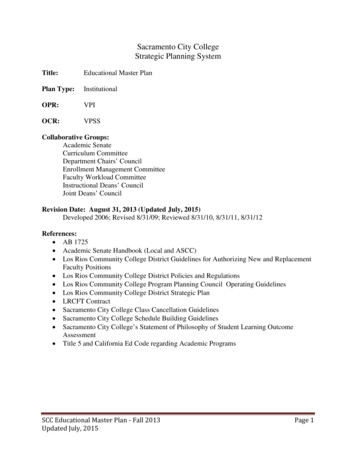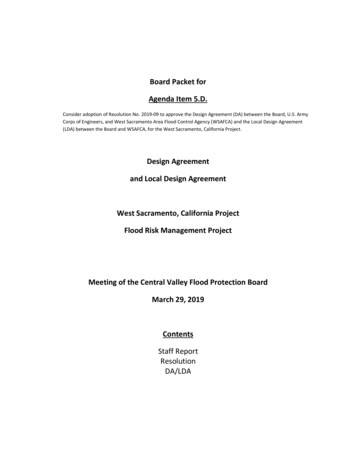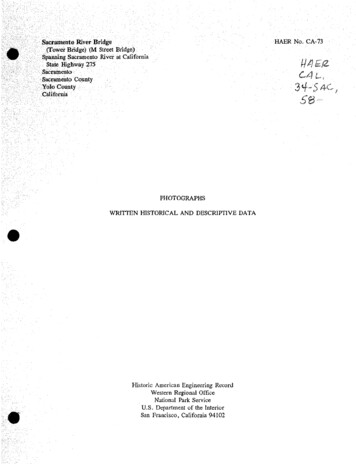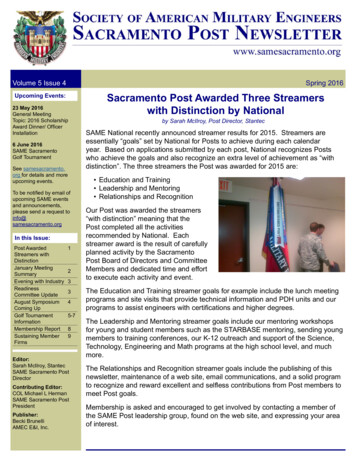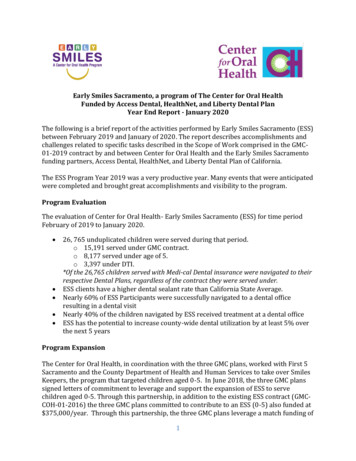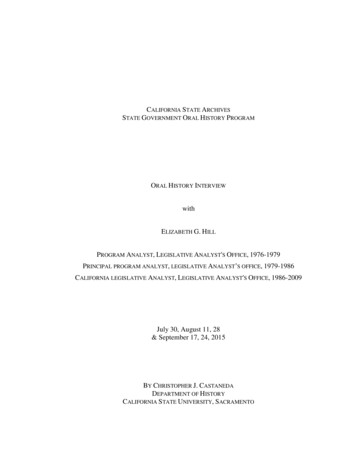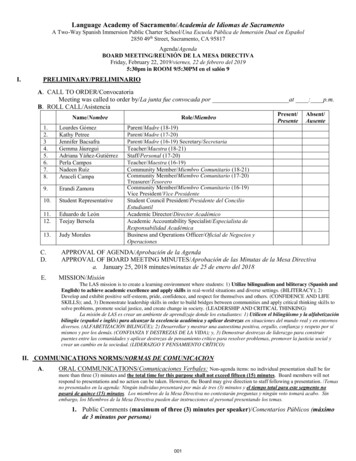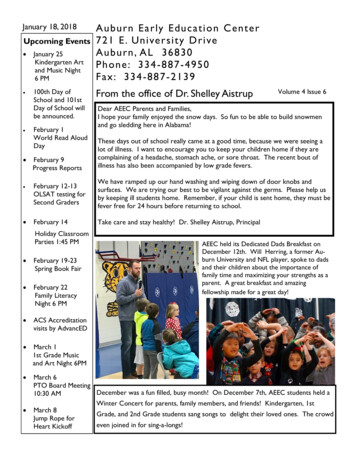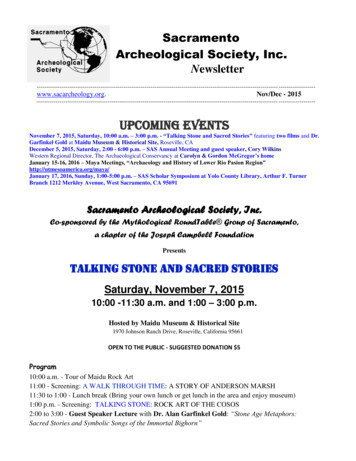
Transcription
SacramentoArcheological Society, --------------------------------------- -------------------www.sacarcheology.org.Nov/Dec - ----------------------------- -------------------UPCOMING EVENTSNovember 7, 2015, Saturday, 10:00 a.m. – 3:00 p.m. - “Talking Stone and Sacred Stories” featuring two films and Dr.Garfinkel Gold at Maidu Museum & Historical Site, Roseville, CADecember 5, 2015, Saturday, 2:00 - 6:00 p.m. – SAS Annual Meeting and guest speaker, Cory WilkinsWestern Regional Director, The Archaeological Conservancy at Carolyn & Gordon McGregor’s homeJanuary 15-16, 2016 – Maya Meetings, “Archaeology and History of Lower Rio Pasion Region”http://utmesoamerica.org/maya/January 17, 2016, Sunday, 1:00-5:00 p.m. – SAS Scholar Symposium at Yolo County Library, Arthur F. TurnerBranch 1212 Merkley Avenue, West Sacramento, CA 95691Sacramento Archeological Society, Inc.Co-sponsored by the Mythological RoundTable Group of Sacramento,a chapter of the Joseph Campbell FoundationPresentsTALKING STONE AND SACRED STORIESSaturday, November 7, 201510:00 -11:30 a.m. and 1:00 – 3:00 p.m.Hosted by Maidu Museum & Historical Site1970 Johnson Ranch Drive, Roseville, California 95661OPEN TO THE PUBLIC - SUGGESTED DONATION 5Program10:00 a.m. - Tour of Maidu Rock Art11:00 - Screening: A WALK THROUGH TIME: A STORY OF ANDERSON MARSH11:30 to 1:00 - Lunch break (Bring your own lunch or get lunch in the area and enjoy museum)1:00 p.m. - Screening: TALKING STONE: ROCK ART OF THE COSOS2:00 to 3:00 - Guest Speaker Lecture with Dr. Alan Garfinkel Gold: “Stone Age Metaphors:Sacred Stories and Symbolic Songs of the Immortal Bighorn”
A WALK THROUGH TIME: A documentary on the rich history of native people and preservation ofAnderson Marsh. The film runs through the 14,000 years that the Koi Nation occupied AndersonMarsh. It was directed by Dan Bruns, a nominated filmmaker from Chico and is entered in this year‟sAmerican Indian Film Festival Copies of the documentary will be available for a suggested donation( 15).TALKING STONE: The largest concentration of rock art in NorthAmerica is hidden away in the canyons of a top secret militarybase on the edge of the Mojave Desert. Created over thousands ofyears by a now vanished culture, it represents the oldest art inCalifornia. The leading expert on the rock art of the Cosos, Dr.Alan Garfinkel Gold, has teamed up with the accomplishedfilmmaker, Paul Goldsmith ASC, to explore and explain thisancient and elegant rock art.Guest Speaker - Dr. Alan Garfinkel GoldPh.D., RPA; Principal Archaeologist; Pacific Rim and Western United StatesUltraSystems Environmental Inc. WBE/DBE/SBE/WOSB“Stone Age Metaphors: Sacred Stories and Symbolic Songs of theImmortal Bighorn”- The context for understanding the Native viewsof the bighorn sheep are many and varied. It appears that theseanimals were something more than a simple subsistence resource.Archaeological sites and specialized features with bighorn bones aredocumented in the Desert West and these prehistoric expressions areexplored. A review of ethnographic accounts, native oral traditionsand indigenous cosmology aid our understanding. Bighorn figurative sculptures and rock art are also adata set that helps us explore the religious and ceremonial significance of this animal to the aboriginalpeople of the Far Western United States.SPEAKER BIO: Dr. Alan Garfinkel Gold is a California and Great Basin anthropologist andarchaeologist. Garfinkel is currently employed as the Principal Archaeologist for the Pacific Rim andWestern United States for UltraSystems Environmental, Inc., a full service engineering andenvironmental compliance firm headquartered in Irvine California with branch offices in six locationsthroughout California. UEI is a 20 year old environmental compliance firm that provides the fullspectrum of cultural resource management services.Garfinkel is also founder and director of the California Rock Art Foundation, a scientific andeducational non-profit corporation dedicated to the conservation and research of the rock art of Upperand Lower California. Garfinkel has authored five books including: Archaeology and Rock Art andthe Handbook of the Kawaiisu and has formally published 50 scientific articles. He is the recipient ofthe 2008 and 2011 California State Governor‟s Award for Historic Preservation. See his website forrelated online articles and additional information.Books and DVDs will be available for purchase
The event is free, but we would welcome small voluntary donations to be for the maintenance of theCalifornia Rock Art Foundation and Sacramento Archeological Society‟s Scholarship Fund.Questions? Please contact John Foster at parkarky@yahoo.com or refer to SAS website orMythological RoundTable Group of Sacramento.Funding Provided By:Ultra Systems Environmental, Inc. and the California Rock Art ***************************************Sacramento Archeological Society, Inc.’sAnnual MeetingFeaturing"The Archaeological Conservancy in CA"ByCory WilkinsWestern Regional DirectorThe Archaeological ConservancySaturday, December 5, 20152:00 – 6:00 p.m.atCarolyn and Gordon McGregor’s home1334 Mission Ave.Carmichael, CA 95608At our annual meeting we are pleased to have Cory Wilkins, Western Regional Director of TheArchaeological Conservancy (TAC) speak on(1) General descriptions of all properties TAC currently owns in California and Nevada(2) A detailed discussion of TAC‟s most recent purchase, the Siemer Preserve on the edge ofBig Valley and near Bieber, announced in TAC‟s attached Fall 2015 American Archaeologymagazine at pages 48-9 by Deanna Commons.(3) Other properties in California and Nevada that TAC is currently considering purchasing.The agenda for the event is as follows:2:00 - Social hour.3:00 - SAS Annual Meeting3:30 - Presentation4:30 – Dinner, socializing, and raffleDinner will be provided by Carolyn McGregor. The menu includes light snacks and wine for the socialhour and a main course of ham, potatoes, green bean casserole, relish plate, rolls and a dessert. Thecost of the dinner and contribution to our scholarship fund is 15 per person. This fee includes oneraffle ticket per person. Additional raffle tickets may be purchased as follows: 1 for 1 or 6 for 5.
In addition students who attend apply the 15 charge to next year‟s membership and no charge will becollected for the dinner.For Carolyn to manage her catering PLEASE provide your RSVP by December 1 to CarolynMcGregor at 916-487-6218 or sabrina53@earthlink.net.Don‟t miss this annual meeting. Bring a ****************************************Annual Scholar SymposiumByScholarship RecipientsSunday, January 17, 20161:00 – 5:00 p.m.atYolo County Library, Arthur F. Turner Branch1212 Merkley Avenue,West Sacramento, CA 95691In 2015 Sacramento Archeological Society awarded five scholarships to supportarcheological/anthropological education. Four of these individuals will be presenting at the ScholarSymposium on January 17, 2016. Naomi Martisius will delay her presentation since she will be out ofthe country continuing her dissertation work on bone tools made by Neandertals. Julia Prince, a 2014scholarship recipient will be on the agenda. Julia Prince‟s the stable isotope analysis of a samplepopulation from the Santa Clara County Valley Medical Center Cemetery for her thesis was delayed.Now she is ready to present her results.Five students will be speaking on the experiences made possible by the scholarships. Allison Blair is a senior at University of Nevada, Reno majoring in Anthropology and English.Her career goal is to become a National Park Ranger. To expand her experience she attendedthe Spike Island Field School in Cobh, Ireland during the 2015 summer. The island housed aprison from the 1800‟s. The school continued to search for missing convict burial grounds.Also excavations of a walled cemetery and the site of the original stockades were planned. Thisproject should provide insights into Ireland‟s prison system. Derek A. Boyd is a graduate student at California State University, Chico majoring inAnthropology. During the summer of 2015 Derek spent a month in London collecting data forhis master‟s theses. He analyzed patterns of trauma on human skeletal remains from twosociao-economically disparate post-Medieval communities. At the Royal College of Surgeonsin London he searched through historical documentation of pathology reports, patient records,and other miscellaneous items to gain an understanding of how trauma was treated in the postMedieval period. We will be anxious to hear the results of his study. Rachel Davies graduated from California State University Sacramento. Her interest is in greatbasin Zooarchaeology. During 2015 summer she participated in the Rimrock Draw Rockshelterfield school. Excavations from this site have produced findings that suggest Western NorthAmerica may have been occupied by pre-Clovis people as early as 16,000 B.P. This lastsummer excavation began in the 7,600 old Mazama volcanic ash layer and worked down. Wewill be excited to hear of the findings.
Leah Hansard is a graduate student at University of California, Davis majoring in Classics.She would like to become a curator of classical art and archaeology and lead excavations in theMediterranean. As a second year participant at Poggio Civitate, she planned to work as aTrench Master-in-Training and deepen her archaeological skill. We will be interested to hearabout the excavation. Julia Prince is a graduate student at California State University Chico majoring inanthropology. She received a scholarship from Sacramento Archeological Society in 2014 tobe applied to her thesis research but was not able to complete the analysis before the last scholarsymposium. She was studying the migration and acculturation that occurred in Santa ClaraValley between 1870 and 1935 by performing stable isotope analysis on a sample populationfrom the Santa Clara County Valley Medical Center Cemetery. This analysis was intended toprovide her information on the types of protein sources, total diet and general indicator ofimmigration status. We are very interested to hear her assessment of the acculturation processfor this region in this period of time.Put Sunday, January 17, 2016 on your calendar. These will be diversely interesting ******************Past Archaeological activitiesSierra Rock Art TourOn September 26 and 27, 2015 archaeologist, Dan Foster,lead a group of 33 rock art enthusiasts on field tours of rockart sites in the Soda Springs area of the Sierra NevadaMountains. The following is a list of sites visited:Saturday, September 26, 20151. CA-PLA-555, Log Cabin Creek Style 7 site2. CA-PLA-26, Soda Springs (Chickering) Style 7 site3. CA-NEV-4, Donner Pass SiteSunday, September 27, 20151. CA-PLA-XXX, Bear Valley Cupules/BRM Style 1site2. CA-PLA-504, Bear Valley Style 7 site3. NEV-426, Spaulding Ridge Style 7 siteIn addition the attendees were honored by four eveningpresentations:“Overview of Style 7 Rock Art by Dan Foster“Migrations of the Great Mural Artists” by Jon Harman“Western Message Petroglyphs” by Leigh Marymor“Style 7 Petroglyphs in the upper Middle Fork of the American River” by Nolan Smith
The event was well organized, fully booked, and veryinstructive. Everyone who attended will understand theimportance of bear tracks for Style 7 rock art. We express ourspecial thanks to the owners and custodians of the privateproperties visited.Texas Archaeological Tourof Pre-Clovis/Clovis/Paleoamerican SitesFrom Monday, October 11, 2015 to Saturday, October 24th Archaeologist, Mike Collins, PhD(Research Associate Professor, Department of Anthropology, Texas State University, San Marcos anddirector of Gault School of Archeological Research (GSAR)) lead 13 Sacramento ArcheologicalSociety members on a fabulous tour of paleo-american sites in Texas. The tour started in Austin, TXand concluded near Houston, TX.The sites visited included: Gault, Wilson-Leonard, Inner Space Cavern, Spring Lake, Knibbe Ranch,Richard Beene, Seminole Canyon, Arenosa Overlook, Eagle Nest, Bonfire (viewed from afar), BigLake Playa, Scharbauer/Midland, Shifting Sands, Black Water Draw (New Mexico), Lake Theo,Alibates Flint Quarry, Miami, Plainview, Lubbock Lake and Horn Shelter. Unfortunately, McFaddinBeach dropped off the itinerary. Tropical Storm Patricia interfered.Additionally, we visited Gault School of Archeological Research Lab, Center for Study of FirstAmericans, and several official and private museums to view artifacts that came from these sites andprivate collections. We thank Mike Collins conducting the tour and the many experts that spoke with uson their expertise. It was truly step into the paleo-american period of history. Refer towww.sacarcheology.org for a photo gallery.After this tour attendees are more familiar with Texas geology, effects of changing climate and thelocation of resources as they shaped the lives and communities of Paleo-indians. For example,ecotones, the areas that border two different geologic regions have been found to have been the homesof paleo-indian communities and are rich in archaeological artifacts. Gault is one such site located atthe border between the Edwards Plateau and the coastal plain. Chert was abundant there and thelocation was a production community. We discovered that the people who used Clovis styled toolswere generalized hunters not just bison hunters and that there are almost as types of paleo-lithic styles(Clovis, Folsom, Midland, Older than Clovis ) as there are archeological discovery sites.Neolithic Burial Tombs and Centers in the British IslesBy Jan JohansenThanks to the organizational work of Ruth McElhinney,six Sacramento Archeological Society members had theprivilege of joining members of the Council for BritishArchaeology for a tour of the Scottish Orkneys inAugust. The visitation of the Orkney monuments wasled by archeologists associated with OrkneyArchaeology Tours(www.orkneyarchaeologytours.co.uk ) and includedNeolithic, Bronze Age, Iron Age, Pictish, Viking andmore modern sites. In many cases we were “told the real
story”. In addition to daily tours, archaeologists gave evening lectures on Neolithic Orkneys, Vikingsand Norse connections, prehistoric sea level research, and coastal erosion.I was particularly fascinated by the burial and “ceremonial” sites. The first site that I entered wasMaeshowe. It looked like a small hill or mound seven meters high. One could circumnavigate it in aditch or henge or climb upon its layers of clay and stone if you were adventurous. At the entrance atriangular stone set in the wall could be moved to block the passage. To my surprise if you madeyourself small by bending over you could enter the structure through a passage and after duck walkingseven meters stand up straight in a relatively large central chamber. The room had a reconstructed roofthat originally had been formed from large slabs of native slate material. A massive slab capped thestructure. Small rooms that could have served as tombs were set in each of three sides. The tomb isthought to have first been in use around 2700 BC though work may have started around 3000 B.C. Itwas visited by Vikings who carved runic marks into the stone chamber walls to left behind as graffiti.Maeshowe is curiously positioned such that on the mid- winter solstice the setting sun shines from thehorizon down the passage and onto the wall at the rear of the main chamber illuminating the entranceto the back cell. This could have signaled the beginning of the end of the cold winter period.Maeshowe was probably not just a tomb. It could easily have been part of a bigger religious landscapethat over time has been buried and lost. Nearby are theStones of Stenness, Ness of Brodgar, and Ring ofBrodgar to name a few of the major monuments.The Ness of Brodgar, a finger of land flanked by twolochs has been under excavation since a strange stone slabwas discovered there in 2003. The site has been dated to3300 B.C. We were fortunate to have Nick Card, thedirector of the excavation, lead the tour of the site. Weviewed the ruins of multiple structures (1, 8, 14 and 10). Iwas impressed by how much has been uncovered and thebeauty and scale of the stonework. The plentiful Orkney flagstone splits easily along horizontal planesand is simple for a craftsman to trim. Razor straight walls and internal partitions are characteristic ofthe structures. Over 600 of the uncovered stones had decorations. These decorations include deepcarving, pecking and cup-marking. Structure 10, known as the temple is acknowledged by some as thefinest Neolithic architecture of Northern Europe. Itmeasures 25 meters long, 19 meters wide and has wallsthat are 4 meters thick. It was built around 2900 BC andused until about 2400 BC when it was mysteriously“decommissioned”.Maeshowe and the Ness of Brodgar were not totallyunique in structure and perhaps purpose. While visitingIreland a few weeks later, we went to Newgrange in theBoyne Valley. Also constructed in 3300 B.C., it is apassage tomb similar to Mashowe, and was reconstructedwith stone from the area. Human remains were found inthe chambers and the sun‟s rays shining through the passage light up the wall at the rear of the mainchamber on the winter solstice just like at Maeshowe. We were told that if you want to see the solsticeevent you can put your name into a lottery. Good luck. The central chamber is not very large.
Election of 2016 Board of DirectorsDuring the Annual Meeting the 2016 Board of Directors will be elected. Additional officerparticipation is always welcome. Please make recommendations to John Foster parkarky@yahoo.com.The slate of the board is:CandidateOfficeJohn FosterPresidentLydia PeakeVice-PresidentCandidateOfficeDennis T. FenwickMember at LargeDan FosterMember at LargeCarolyn McGregorSecretaryJeremy JohansenMember at LargeDiane SangsterTreasurerJan JohansenMember at LargeTom JohansenMember at LargeRuth McElhinneyMember at LargeRoger PeakeMember at LargeMember at LargeArchaeological References“New Mystery for Native American Origins”Two recent publications in Science and Nature introduce new questions as to the origin of NativeAmericans. Both detected in modern Native Americans a trace of DNA related to that of native peoplefrom Australia and Melanesia. The two studies differ in their analysis of how and when therelationship occurred. The Science team lead by David Meltzer at Southern Methodist University inDallas “concluded that all Native Americans, ancient and modern, stem from a single sourcepopulation in Siberia that split from other Asian around 23,000 years ago and moved into the nowdrowned land of Beringia. After a stop of up to 8000 years they spread in a single wave into theAmericas and then split into northern and southern branches about 13,000 years ago.”Geneticist David Reich o Harvard Medical School and leader of the Nature team suggests that thisancestry did not come directly from these populations, the team concludes, but through a now extinctpopulation they call „Population Y‟ that may have lived somewhere in East Asia and contributed genesto both very early Paleoamericans and to Australo-Melanesians.(Michael Balter, 2015-7-24, Science, p. 354-355)“New Life for Old Bones”DNA analysis has entered explosive growth due to improved techniques. Several articles highlight therevelations that are occurring in the field. These include “Revolution in Human Evolution”, “LostWorlds Found – Sugar cubes of buried soil reveal how ecosystems warmed after the last ice age” and“Breaking a Tropical Taboo – Most ancient DNA comes from frigid environs. Can new methodssample hot and humid locales?” (2015-7-24, Science, p. 358-373)
Sacramento Archeological Society, Inc. Newsletter www.sacarcheology.org. Nov/Dec - 2015 UPCOMING EVENTS November 7, 2015, Saturday, 10:00 a.m. - 3:00 p.m. - "Talking Stone and Sacred Stories" featuring two films and Dr. Garfinkel Gold at Maidu Museum & Historical Site, Roseville, CA December 5, 2015, Saturday, 2:00 - 6:00 p.m. - SAS Annual Meeting and guest speaker, Cory Wilkins
